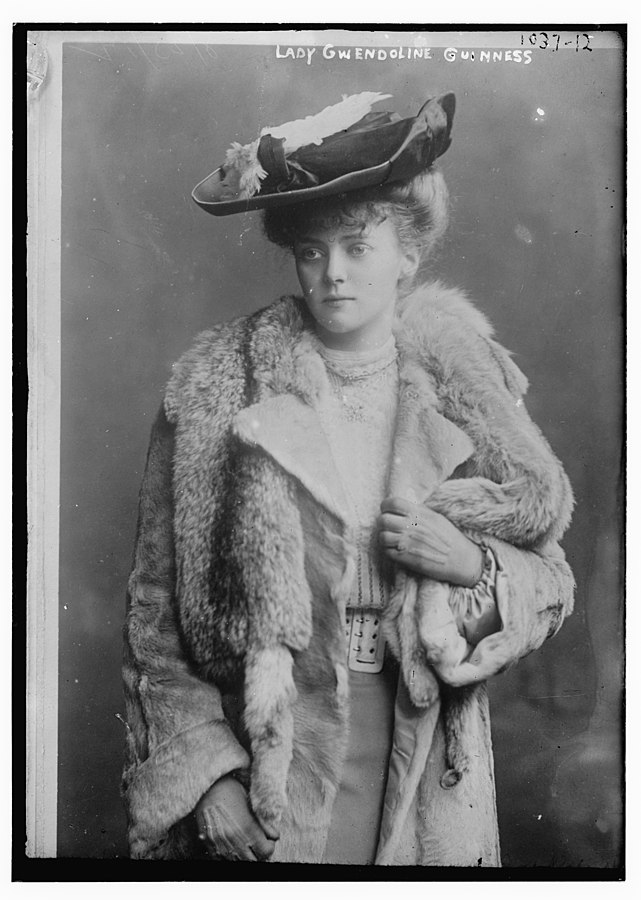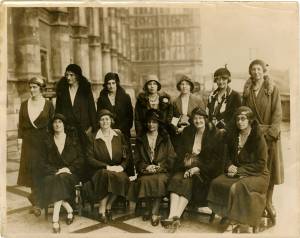by Niall McFadden.
To celebrate International Women’s Day on the 8th of March, I’d like to focus on a figure connected to the life of Farmleigh who played a pioneering role in advancing women’s political rights in the 1920’s and 1930’s. For eight years from 1927 to 1935, Gwendolen Guinness sat as one of the very few women MP’s in the House of Commons. At the time her role was revolutionary in social terms, women of the time having barely achieved the right to vote or represent others politically. She could be said to have set the trail for others to follow and she deserves to be remembered as we celebrate this day.
Born Gwendolen Onslow in 1881, the eldest daughter of William Hiller, fourth Earl of Onslow, Gwendolen got a taste of public like and public service from a very young age. Her father served as Governor of New Zealand before returning with his family to political life in London. The young Gwendolen was described as serious-minded and every bit as committed to politics as her male relatives, taking a keen interest in the reform issues of the day. In 1903, she married Rupert Guinness, heir to the brewing dynasty as the eldest son of Edward Cecil Guinness, owner of Farmleigh. The couple settled in in Shoreditch in East London where Rupert contested the Haggerston constituency, being elected for the Conservatives in 1908. It was a deprived area and through her constituency work, Gwendolen got an appreciation for the wider societal issues at play. Rupert lost the seat the following year but was re-elected later in the constituency of Southend-On-Sea. In the meantime, the First World War intervened and Gwendolen devoted much of her time to The National Prisoners of War Fund, distributing food and clothing to prisoners of war, a role for which she was later honoured.

George Grantham Bain Collection. Library of Congress.
The aftermath of the war caused huge societal changes in Britain and the year 1927 was to bring big changes in the life of Gwendolen and Rupert. Edward Guinness, 1st Earl of Iveagh died and the title passed to Rupert meaning he now took a place in the House of Lords (amongst other consequences was Farmleigh House and estate passing to Rupert). This necessitated a by-election in Southend-On -Sea. The question arose as who would stand as a candidate to contest the seat. Suggestions were made that Gwendolen, steeped in politics from a young age and very temperamentally suited, would make an excellent candidate. Notwithstanding her connections, background and grassroots experience, this was a radical suggestion for the society of the day. The number of female MP’s in The House of Commons at the time could almost be counted on one hand. Constance Markiewicz had been the first woman elected to Parliament in the general election of 1918, refusing to take her seat. (She did sit in the first Dáil Éireann becoming Minister for Labour). Viscountess Nancy Astor had been the first elected woman to sit as an MP in Westminster the following year. Ironically, whilst women had had the same right as men to stand for election since 1918, voting rights in an election in 1927 still distinguished between gender. The Representation of The People Act of 1918 had restricted the right to vote in elections to women over the age of 30 who met a property qualification threshold. In contrast, all men over the age of 21 gained the right to vote. This led to absurd anomalies such as the case of Labour MP, Jennie Lee, elected in a by-election at the age of 24 yet unable to vote for herself in the same election. The reasoning behind the difference in treatment was a supposed fear that to give equal voting rights to men and women would lead to a majority of women voters. It was not until 1928 that The Representation of The People (Equal Franchise Act) 1928 levelled the playing field in Britain. In newly-independent Ireland, matters were no better in reality. The Free State Constitution of 1922 had given men and women over the age of 21 equal right to both stand for and vote in elections, but by the end of 1927, the year of the Southend-On-Sea by-election across the water, the number of female TDs in Dáil Éireann was just one ( Margaret Collins-O’Driscoll TD representing Cumann Na nGaedheal). It was against this background that Gwendolen accepted a nomination to contest the seat. She secured a comfortable majority over the Liberal opponent, Douglas Meston, and prepared to take her seat for the first time.

Female MPs in November 1931 on the terrace at Westminster. Gwendolen seated in the front row second from left. UK Parliamentary Archives.
The House of Commons in those days would have been an intimidating environment for the seven women MP’s, with hundreds of men shouting over each other and waving order papers in the air. Attitudes amongst male MP’s included the suggestion that if women wanted to participate in public life then they should form a parliament of their own. It wasn’t just fellow MP’s that embraced these attitudes. One Daily Telegraph parliamentary report of June 1934 reported that MPs were rushing to see the Countess of Iveagh speak in the chamber ,”eager to see her fashionable clothes”. The substance of what she said might not have been of much interest to the correspondent of The Daily Telegraph but she did make important contributions, speaking in defence of The Representation of the People Act of 1928 that gave equal voting rights to women and venturing into traditional male areas such as naval matters that impacted on her constituency of Southend-On-Sea. She was described as a renowned orator, witty and personable and was a favourite of her party. Her Commons career was not destined to be a long one. In 1935, she resigned her seat in order to make way for her son-in-law, Henry “Chips” Channon to stand. Channon was an ambitious Anglo-American socialite, married to Gwendolen’s daughter Honor. Perhaps there were internal family pressures. She was certainly relatively young when she stood down, being just 55 years of age. Just as likely, wider backward societal attitudes that a woman should make way for a man played their part. She spent her later years engaged in family engagements as Countess of Iveagh, visiting Ireland and Farmleigh quite regularly. Herself and Rupert for example opened The Iveagh Sports Grounds on The Crumlin Road in Dublin. She had three daughters, Honor, Patricia and Brigid and two sons, Richard who died in infancy and Arthur, killed in action towards the end of The Second World War in the Netherlands, aged just 32.

Gwendolen Florence Mary Guinness née Onslow Countess of Iveagh and Rupert Edward Cecil Lee Guinness 2nd Earl of Iveagh. National Portrait Gallery.
Today much progress has been made in advancing female representation in politics. To take one example, Helen McEntee, Minister for Justice, has recently been the first cabinet minister to take maternity leave. Women are better represented in Dáil Éireann although quite a bit more needs to be done to achieve balance in numbers in the Dáil. Currently about one fifth of TD’s are women. In the UK, roughly 33% of MP’s are women. In looking back at the contribution of Gwendolen Guinness, it can be said she played a not insignificant part on the road to that progress and was a pioneer in her day.


